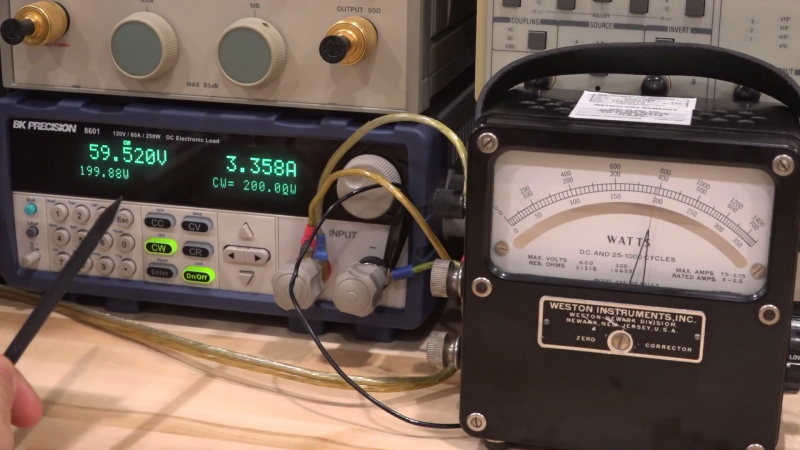Measuring power transfer through a circuit seems a simple task. Measure the current and voltage, do a little math courtesy of [Joule] and [Ohm], and you’ve got your answer. But what if you want to design an instrument that does the math automatically? And what if you had to do this strictly electromechanically?
That’s the question [Shahriar] tackles in his teardown of an old lab-grade wattmeter. The video is somewhat of a departure for him, honestly; we’re used to seeing instruments come across his bench that would punch a seven-figure hole in one’s wallet if acquired new. These wattmeters are from Weston Instruments and are beautiful examples of sturdy, mid-century industrial design, and seem to have been in service until at least 2013. The heavy bakelite cases and sturdy binding posts for current and voltage inputs make it seem like the meters could laugh off a tumble to the floor.
But as [Shahriar] discovers upon teardown of a sacrificial meter, the electromechanical movement behind the instrument is quite delicate. The wattmeter uses a moving coil meter much like any other panel meter, but replaces the permanent magnet stator with a pair of coils. The voltage binding posts are connected to the fine wire of the moving coil through a series resistance, while the current is passed through the heavier windings of the stator coils. The two magnetic fields act together, multiplying the voltage by the current, and deflect a needle against a spring preload to indicate the power. It’s quite clever, and the inner workings are a joy to behold.
We just love looking inside old electronics, and moving coil meters especially. They’re great gadgets, and fun to repurpose, too.















” The two magnetic fields act together, multiplying the voltage by the current, and deflect a needle against a spring preload to indicate the power. It’s quite clever, and the inner workings are a joy to behold.”
Whatever did we do before digital was invented? ;-)
“Whatever did we do before digital was invented? ;-)”
Build things using hacks upon hacks.
The world was ANALOG, and still is!
Instruments from this era were truly engineered. They didn’t copy circuits from a datasheet and throw some code at it like the newer instruments are made. These were truly thought out, calculations made and craftsmen put the ideas together into a work of art. And they worked, without question about accuracy, for what seemed like forever.
Those were the days!
Yes, but today we ask questions about accuracy. And also about logging of measurements. Therefore we went digital.
It had rather less to do with that and rather more to do with cost. There’s some fascinating reading to be had on constructing an AM transmitter with effectively only logic gates, as well as other digital replacements for analog circuits.
If I recall correctly, the synth chip in the speak and spell had a ten stage pipeline emulating the human vocal tract, with the transfer functions of each stage implemented in some sort of fixed point math logic rather than analog filters, despite being laid out from a logistical point like it used them.
Fundamentally, digital logic elements and crystals are easier to make reproducibly and so don’t require manual tuning for each unit produced, saving in labor costs. The on-chip density (and thus low cost of manufacture) is a cherry on top.
I have an old Bakelite wattmeter at home, it is about half of the width of that one.
I’ve never used it, it is an ornament for my workbench, (along with the Bakelite voltmeter, milliamp meter, amp meter of the same family).
Cool story
Looking at theses beauties is always so inspiring. The amount of design effort that was put on the scales (and mechanics) is really admirable. These devices embody so much of EE professionalism, industrial design perfection, and, foremost, the scientific approach of a measuring/experimenting! Having them on your bench is a good way to get reminded of these ideals on a bad day full of bugs/shorts/bureaucracy/you name it. I.e. +1!
I like the way the calibration stickers block the ventilation holes.
I wonder what physics engine they used back then?
:o)
The “fundamental laws of” physics engine.
Bah. Everybody in an engineering department that reports to Sales knows that those laws don’t exist.
Then that is a very bad constellation. Do it the other way round.
The exact same technology spins the watt-hour meter outside your house.
Mine’s digital.
Mine’s is “smart” *facepalm*
But they left out the spring.
I’ve got a meter in a variac that works the same way
https://paulcarbone.com/blog/tu-75b-wattmeter-repair/
Duncan Meter made ’em by the millions for something like half of the US in one plant in Lafayette. How they worked was covered well in high school. That’s all gone now, a fine acoustic hall exists.